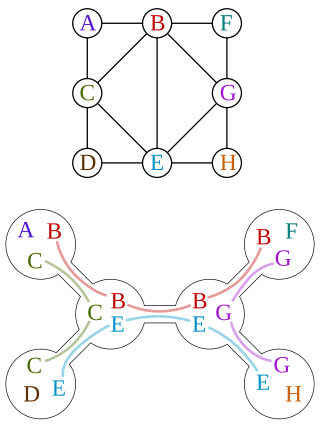Related Research Articles

Robert Endre Tarjan is an American computer scientist and mathematician. He is the discoverer of several graph theory algorithms, including his strongly connected components algorithm, and co-inventor of both splay trees and Fibonacci heaps. Tarjan is currently the James S. McDonnell Distinguished University Professor of Computer Science at Princeton University.

In graph theory, a tree decomposition is a mapping of a graph into a tree that can be used to define the treewidth of the graph and speed up solving certain computational problems on the graph.

In the mathematical theory of directed graphs, a graph is said to be strongly connected if every vertex is reachable from every other vertex. The strongly connected components of a directed graph form a partition into subgraphs that are themselves strongly connected. It is possible to test the strong connectivity of a graph, or to find its strongly connected components, in linear time (that is, Θ(V + E )).
The structured program theorem, also called the Böhm–Jacopini theorem, is a result in programming language theory. It states that a class of control-flow graphs can compute any computable function if it combines subprograms in only three specific ways. These are
- Executing one subprogram, and then another subprogram (sequence)
- Executing one of two subprograms according to the value of a boolean expression (selection)
- Repeatedly executing a subprogram as long as a boolean expression is true (iteration)
In graph theory, the treewidth of an undirected graph is an integer number which specifies, informally, how far the graph is from being a tree. The smallest treewidth is 1; the graphs with treewidth 1 are exactly the trees and the forests. The graphs with treewidth at most 2 are the series–parallel graphs. The maximal graphs with treewidth exactly k are called k-trees, and the graphs with treewidth at most k are called partial k-trees. Many other well-studied graph families also have bounded treewidth.
In computer science, Kosaraju-Sharir's algorithm is a linear time algorithm to find the strongly connected components of a directed graph. Aho, Hopcroft and Ullman credit it to S. Rao Kosaraju and Micha Sharir. Kosaraju suggested it in 1978 but did not publish it, while Sharir independently discovered it and published it in 1981. It makes use of the fact that the transpose graph has exactly the same strongly connected components as the original graph.
In graph theory, a path decomposition of a graph G is, informally, a representation of G as a "thickened" path graph, and the pathwidth of G is a number that measures how much the path was thickened to form G. More formally, a path-decomposition is a sequence of subsets of vertices of G such that the endpoints of each edge appear in one of the subsets and such that each vertex appears in a contiguous subsequence of the subsets, and the pathwidth is one less than the size of the largest set in such a decomposition. Pathwidth is also known as interval thickness, vertex separation number, or node searching number.

Ravindran Kannan is a Principal Researcher at Microsoft Research India, where he leads the algorithms research group. He is also the first adjunct faculty of Computer Science and Automation Department of Indian Institute of Science.
A geometric spanner or a t-spanner graph or a t-spanner was initially introduced as a weighted graph over a set of points as its vertices for which there is a t-path between any pair of vertices for a fixed parameter t. A t-path is defined as a path through the graph with weight at most t times the spatial distance between its endpoints. The parameter t is called the stretch factor or dilation factor of the spanner.

Mihalis Yannakakis is professor of computer science at Columbia University. He is noted for his work in computational complexity, databases, and other related fields. He won the Donald E. Knuth Prize in 2005.

Georg Gottlob FRS is an Austrian-Italian computer scientist who works in the areas of database theory, logic, and artificial intelligence and is Professor of Informatics at the University of Calabria. He was Professor at the University of Oxford.
In graph theory, the planar separator theorem is a form of isoperimetric inequality for planar graphs, that states that any planar graph can be split into smaller pieces by removing a small number of vertices. Specifically, the removal of vertices from an n-vertex graph can partition the graph into disjoint subgraphs each of which has at most vertices.
Kosaraju (1905–1987) is Telugu poet and lyricist.
Mikhail Jibrayil (Mike) Atallah is a Lebanese American computer scientist, a distinguished professor of computer science at Purdue University.
In the study of graph algorithms, Courcelle's theorem is the statement that every graph property definable in the monadic second-order logic of graphs can be decided in linear time on graphs of bounded treewidth. The result was first proved by Bruno Courcelle in 1990 and independently rediscovered by Borie, Parker & Tovey (1992). It is considered the archetype of algorithmic meta-theorems.
In computational geometry, a well-separated pair decomposition (WSPD) of a set of points , is a sequence of pairs of sets , such that each pair is well-separated, and for each two distinct points , there exists precisely one pair which separates the two.
Sambasiva Rao (సాంబశివరావు) is an Indian given name. Notable people with the name include:

In graph theory, a split of an undirected graph is a cut whose cut-set forms a complete bipartite graph. A graph is prime if it has no splits. The splits of a graph can be collected into a tree-like structure called the split decomposition or join decomposition, which can be constructed in linear time. This decomposition has been used for fast recognition of circle graphs and distance-hereditary graphs, as well as for other problems in graph algorithms.
Daniel Mier Gusfield is an American computer scientist, Distinguished Professor of Computer Science at the University of California, Davis. Gusfield is known for his research in combinatorial optimization and computational biology.
Satish B. Rao is an American computer scientist who is a professor of computer science at the University of California, Berkeley.
References
- ↑ Staff Announcement – CCF, Farnam Jahanian, NSF, retrieved 2014-01-14.
- 1 2 "S. Rao Kosaraju's home page". www.cs.jhu.edu. Retrieved 31 October 2016.